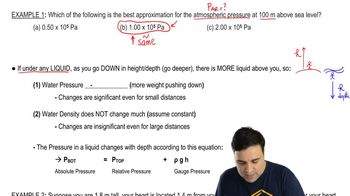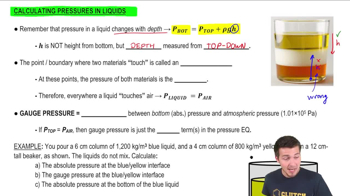>> Let's talk about the big equation for this chapter which is Bernouilli's equation. Okay. Bernouilli's equation, that might be one of those equations that you've heard thrown around before. Whenever they talked about fluid flow, lift of an airplane, drag, somebody's going to mention Bernouilli's equation. So this comes into play in a lot of physics problems. Let's see how we can model it. And to do that, let's go back to our pipe and let's flow that fluid uphill. So here's our pipe. We're going to flow the fluid up this hill. And let's write down some parameters for this pipe. So we said that there's a mass of water, m. That same mass has to exit the pipe if we have continuity. This is moving at v1. This is moving at v2. But now there's a height here, y1. And there's a height here, y2. And these occupy some length, delta x1, some length, delta x2. And now there has to be some driving force to push this thing up. We'll call that F1. It's going to act on the end of the pipe, cross sectional area A1. And there might be some force pushing back against you, F2, acting on the end of the pipe, A2. Those are all the parameters that we need to now derive Bernouilli's equation. Bernouilli's equation is really not so complicated because it is completely analogous to conservation of energy. It's basically conservation of energy for fluids. So when you have fluids moving, you have kinetic energy. Anything moving has kinetic energy. When you have them going up a hill, you have gravitational potential energy. When you're applying a force, you're doing work. All of that stuff is energy. And so really Bernouilli's equation is nothing more than conservation of energy. So let's set up the problem and then we're going to skip a little bit of the math and we're going to jump to the solution. And then we'll see how we can apply that solution. Okay. The work involved in moving the fluid is going to be what? Well, we have F1 delta x1 pushing this fluid up. There's some work of this one trying to go the other way, but the fluid is still moving up and so we have to make a minus sign F2 delta x2. All right. But we know that force relates to pressure. This is P1 times A1. This is P2 times A2. And A1 times delta x1, that is a volume. A2 times delta x2, that is a volume. What's the volume of this fluid? What's the volume of this fluid? Now right off the bat you should look at this and go, "Wait a minute. That sounds like something I learned about in chemistry." Work equals P delta V. P times V, that is work. All right. So you might remember this from your chemistry classes. But the volume here is the same, right. The mass going in has to be equal to the mass going out. The density doesn't change. And so the volumes are in fact equal. And we will just define that as V. And so work is P1 minus P2 times V. That's one of the terms that we're going to need. Let's see if we can calculate the other terms that we're going to need and we'll put it all together. All right. Let's separate the terms. We've got P1 times V. I'm going to move this v1 term over to the other side. So we have one-half m v1 squared. And now I'm going to move the y1 term over to the left side. So I have mgy1. And now all the stuff on the right I want to leave as number two. So let's move P2 over to the right side. And we have a one-half m v2 squared. And we have an mgy2. All right. That looks pretty good except I don't really like this volume V. And I tried to write capital V and small v because this one's a speed, this is a volume. So let's divide everything by V. If I divide everything by V, what's going to happen? That goes away. I put a capital V down there. I put a capital V down there. That goes away. This, we put a capital V down there. And that we put a capital V down there. And that looks pretty good because mass over volume is density. And so this becomes rho times v1 squared. Mass over volume, that's density, rho gy1. The right side P2 plus one-half rho v2 squared plus rho gy2. And guess what? That is Bernouilli's equation. Conservation of energy applied to fluids, this is what you end up with. It says at one end of the pipe if you have all these terms, pressure 1, speed v1, height y1, you know that that is a constant. And if I go to the other end of the pipe, those same things have to add up to equal the same number. Okay. Bernouilli's equation is very, very powerful.
Table of contents
- 0. Math Review31m
- 1. Intro to Physics Units1h 23m
- 2. 1D Motion / Kinematics3h 56m
- Vectors, Scalars, & Displacement13m
- Average Velocity32m
- Intro to Acceleration7m
- Position-Time Graphs & Velocity26m
- Conceptual Problems with Position-Time Graphs22m
- Velocity-Time Graphs & Acceleration5m
- Calculating Displacement from Velocity-Time Graphs15m
- Conceptual Problems with Velocity-Time Graphs10m
- Calculating Change in Velocity from Acceleration-Time Graphs10m
- Graphing Position, Velocity, and Acceleration Graphs11m
- Kinematics Equations37m
- Vertical Motion and Free Fall19m
- Catch/Overtake Problems23m
- 3. Vectors2h 43m
- Review of Vectors vs. Scalars1m
- Introduction to Vectors7m
- Adding Vectors Graphically22m
- Vector Composition & Decomposition11m
- Adding Vectors by Components13m
- Trig Review24m
- Unit Vectors15m
- Introduction to Dot Product (Scalar Product)12m
- Calculating Dot Product Using Components12m
- Intro to Cross Product (Vector Product)23m
- Calculating Cross Product Using Components17m
- 4. 2D Kinematics1h 42m
- 5. Projectile Motion3h 6m
- 6. Intro to Forces (Dynamics)3h 22m
- 7. Friction, Inclines, Systems2h 44m
- 8. Centripetal Forces & Gravitation7h 26m
- Uniform Circular Motion7m
- Period and Frequency in Uniform Circular Motion20m
- Centripetal Forces15m
- Vertical Centripetal Forces10m
- Flat Curves9m
- Banked Curves10m
- Newton's Law of Gravity30m
- Gravitational Forces in 2D25m
- Acceleration Due to Gravity13m
- Satellite Motion: Intro5m
- Satellite Motion: Speed & Period35m
- Geosynchronous Orbits15m
- Overview of Kepler's Laws5m
- Kepler's First Law11m
- Kepler's Third Law16m
- Kepler's Third Law for Elliptical Orbits15m
- Gravitational Potential Energy21m
- Gravitational Potential Energy for Systems of Masses17m
- Escape Velocity21m
- Energy of Circular Orbits23m
- Energy of Elliptical Orbits36m
- Black Holes16m
- Gravitational Force Inside the Earth13m
- Mass Distribution with Calculus45m
- 9. Work & Energy1h 59m
- 10. Conservation of Energy2h 54m
- Intro to Energy Types3m
- Gravitational Potential Energy10m
- Intro to Conservation of Energy32m
- Energy with Non-Conservative Forces20m
- Springs & Elastic Potential Energy19m
- Solving Projectile Motion Using Energy13m
- Motion Along Curved Paths4m
- Rollercoaster Problems13m
- Pendulum Problems13m
- Energy in Connected Objects (Systems)24m
- Force & Potential Energy18m
- 11. Momentum & Impulse3h 40m
- Intro to Momentum11m
- Intro to Impulse14m
- Impulse with Variable Forces12m
- Intro to Conservation of Momentum17m
- Push-Away Problems19m
- Types of Collisions4m
- Completely Inelastic Collisions28m
- Adding Mass to a Moving System8m
- Collisions & Motion (Momentum & Energy)26m
- Ballistic Pendulum14m
- Collisions with Springs13m
- Elastic Collisions24m
- How to Identify the Type of Collision9m
- Intro to Center of Mass15m
- 12. Rotational Kinematics2h 59m
- 13. Rotational Inertia & Energy7h 4m
- More Conservation of Energy Problems54m
- Conservation of Energy in Rolling Motion45m
- Parallel Axis Theorem13m
- Intro to Moment of Inertia28m
- Moment of Inertia via Integration18m
- Moment of Inertia of Systems23m
- Moment of Inertia & Mass Distribution10m
- Intro to Rotational Kinetic Energy16m
- Energy of Rolling Motion18m
- Types of Motion & Energy24m
- Conservation of Energy with Rotation35m
- Torque with Kinematic Equations56m
- Rotational Dynamics with Two Motions50m
- Rotational Dynamics of Rolling Motion27m
- 14. Torque & Rotational Dynamics2h 5m
- 15. Rotational Equilibrium3h 39m
- 16. Angular Momentum3h 6m
- Opening/Closing Arms on Rotating Stool18m
- Conservation of Angular Momentum46m
- Angular Momentum & Newton's Second Law10m
- Intro to Angular Collisions15m
- Jumping Into/Out of Moving Disc23m
- Spinning on String of Variable Length20m
- Angular Collisions with Linear Motion8m
- Intro to Angular Momentum15m
- Angular Momentum of a Point Mass21m
- Angular Momentum of Objects in Linear Motion7m
- 17. Periodic Motion2h 9m
- 18. Waves & Sound3h 40m
- Intro to Waves11m
- Velocity of Transverse Waves21m
- Velocity of Longitudinal Waves11m
- Wave Functions31m
- Phase Constant14m
- Average Power of Waves on Strings10m
- Wave Intensity19m
- Sound Intensity13m
- Wave Interference8m
- Superposition of Wave Functions3m
- Standing Waves30m
- Standing Wave Functions14m
- Standing Sound Waves12m
- Beats8m
- The Doppler Effect7m
- 19. Fluid Mechanics2h 27m
- 20. Heat and Temperature3h 7m
- Temperature16m
- Linear Thermal Expansion14m
- Volume Thermal Expansion14m
- Moles and Avogadro's Number14m
- Specific Heat & Temperature Changes12m
- Latent Heat & Phase Changes16m
- Intro to Calorimetry21m
- Calorimetry with Temperature and Phase Changes15m
- Advanced Calorimetry: Equilibrium Temperature with Phase Changes9m
- Phase Diagrams, Triple Points and Critical Points6m
- Heat Transfer44m
- 21. Kinetic Theory of Ideal Gases1h 50m
- 22. The First Law of Thermodynamics1h 26m
- 23. The Second Law of Thermodynamics3h 11m
- 24. Electric Force & Field; Gauss' Law3h 42m
- 25. Electric Potential1h 51m
- 26. Capacitors & Dielectrics2h 2m
- 27. Resistors & DC Circuits3h 8m
- 28. Magnetic Fields and Forces2h 23m
- 29. Sources of Magnetic Field2h 30m
- Magnetic Field Produced by Moving Charges10m
- Magnetic Field Produced by Straight Currents27m
- Magnetic Force Between Parallel Currents12m
- Magnetic Force Between Two Moving Charges9m
- Magnetic Field Produced by Loops and Solenoids42m
- Toroidal Solenoids aka Toroids12m
- Biot-Savart Law (Calculus)18m
- Ampere's Law (Calculus)17m
- 30. Induction and Inductance3h 37m
- 31. Alternating Current2h 37m
- Alternating Voltages and Currents18m
- RMS Current and Voltage9m
- Phasors20m
- Resistors in AC Circuits9m
- Phasors for Resistors7m
- Capacitors in AC Circuits16m
- Phasors for Capacitors8m
- Inductors in AC Circuits13m
- Phasors for Inductors7m
- Impedance in AC Circuits18m
- Series LRC Circuits11m
- Resonance in Series LRC Circuits10m
- Power in AC Circuits5m
- 32. Electromagnetic Waves2h 14m
- 33. Geometric Optics2h 57m
- 34. Wave Optics1h 15m
- 35. Special Relativity2h 10m
19. Fluid Mechanics
Intro to Pressure
Video duration:
7mPlay a video:
Related Videos
Related Practice


















